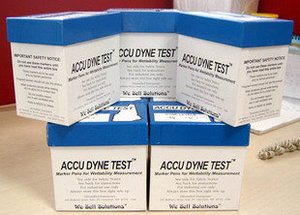達因筆 張力計 電暈筆
規格介紹:達因筆 張力計 電暈筆
原裝進口電暈筆有30、32、34、36、38、40、42、44、46、48、50、52、54、56、58、60標準規格的試筆,能準確地測試出塑膠薄膜表面張力是否達到試筆的數值。
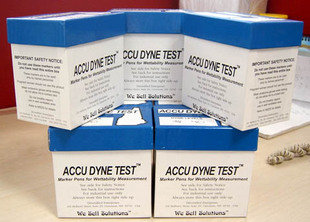
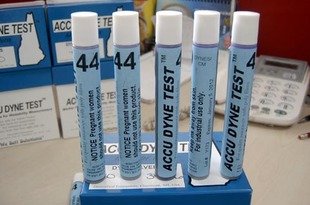
聯絡海山http://hi-sun.com.tw/contact-us.html
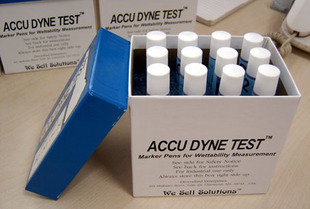
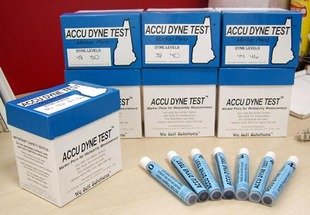
概述:
達因筆能準確的測試出塑膠薄膜之表面張力是否達到試筆的數值。令使用者清楚的瞭解此薄膜是否適合於印刷,複合或真空鍍鋁。有效的控制品質及減少因材質不合格所造成的工具延誤。它並不僅限於塑膠薄膜,還可以測試各種材料的表面張力。
原裝進口電暈筆有30、32、34、36、38、40、42、44、46、48、50、52、54、56、58、60標準規格的試筆,能準確地測試出塑膠薄膜表面張力是否達到試筆的數值。令使用者清楚瞭解此薄膜是否適合於印刷、複合或真空鍍鋁等等,從而有效地控制品質,減少因材質不合格所造成的損失。
一般來說,基材形成墨滴,塗層和粘貼能力和表面的能量相關。如果基材表面的能量低於所塗測試液的表面的張力,則形成珠點和畫線收縮。因而,對大多數的基於印刷,塑膠的溶劑來說,測試筆的要求在36-40達因/釐米之間。基於墨的些液體要求測試筆在40-44達因/釐米之間。而一些碾壓和塗層的應用要求表面能量在50達因/釐米或者以上。顯而易見,在進行印刷,塗層和碾壓前需要對表面的能量先預估。
ACCU達因筆在絕大多數的非粘貼性的材料上表現良好。重要的是測試液不會改變基材的表面特性。例如,如果測試液滲入一個纖維基材(如紙)致使膨脹,結果可以說明其容易潮濕。基材和測試液間的生化反應使結果無效。
達因筆基本使用方法
測試時,應選擇一個中間值來作起點,如38mN/m,測試時,如果在2秒內測試筆濕了基材表面,則基材表面張力比所選值要大或正好,那麼須要選一更大值的測試筆進行第二次測試,如此類推,直到測試結果在2秒內改縮成水珠(球狀),則這次測試之前一次的值就被視為基材的表面能。並以此作比較分析用。
將表面張力測試筆垂直於要測試的材料表面,在表面均勻的畫上一條直線,如果連續成直線,沒有產生收縮現象,則表明該物件表面張力已經達到試筆的張力值。如果斷斷續續,並凝聚成小水珠,則表明未達到試筆的張力值。
達因測試結果分析:
1、畫線很平均地分佈,不起任何珠點,則說明該薄膜表面張力,高於達因筆上所標出的指數,這種情況可以印刷。
2、畫線慢慢地收縮,則說明該薄膜表面張力,稍低於達因筆上所標出的指數。這種情況印刷效果不好。
3、畫線立即收縮,並且形成珠點,則說明該薄膜表面張力,很低於達因筆所標出的指數。這種情況不能印刷。
為了確保歐美達因筆測試結果的可重複性,材料的準備和測試的方法必須標準化。ASTM STD D6182協議規定了測試條件以及方法。遺憾的是,這個協議不適用於膠片的測試。測試時間的範圍在24小時到72小時,這種苛刻的要求也許對於R&D是有適合的,但對於普通的QC測試來說,所設定的時間也許短了一點。檢測理論認為將周圍環境,基材,和測試方法的標準化是很重要的,。培訓師教導檢測人員要將所有變化最小化。相對濕度不應超過標準,硬度過高易加劇資料的可變性。最終,需要控制測試擠壓或塗層(印刷)的時間。
以下為英文參數(附表):
Recommended Treatment Levels
The following chart offers general guidelines regarding the required surface treatment levels (as measured by the dyne test) for various process/material combinations.
Please note it is critical that the appropriate specification is determined for each job, based on actual empirical results from functional finished product testing. The
ranges shown here can be used to expedite surface analysis by suggesting a reasonable range within which to test. Blind reliance on this data will probably reduce
your quality costs short term and ensure a large discrepant goods writeoff at some uncertain future date.
In most cases, jobs can be run if the substrate – at run-time – is somewhere between the low and high dyne levels cited. For demanding runs (e.g., high web speeds
and/or critical quality process work), it is safest to shoot for the top of the range. Use this chart as a general guideline only: each operation has slightly different
requirements. These data are for flame or corona treatment in an oxygen-containing atmosphere.
NOTES:
(1) Some values theoretical.
(2) Any density, any type, including films, coated board, and molded products.
(3) All types; cast or molded.
(4) More plasticizer generally requires levels at the high end of these ranges.
(5) Uncoated.
(6) For heat sealing, the surface energies of the mating PE surfaces should match closely; if both faces are treated, heat sealing can usually be accomplished over a
broader and lower temperature range.
推薦的表面張力標準。
以下的表格為在不同的印刷過程和材料的基礎上基底材料所需的表面達因值的提供了通用的指引,以下表格的資料是根據實際的測試情況得出的經驗資料,表格中所示的合理範圍資料可以加快您的表面分析的速度,短期內減少您的品質控制成本。
在很多情況下,在測試的時候,被測的基地材料表面不同的地方的達因值在表格所示的最高和最低之間,作為解決辦法,應該採用高的那個值。所有測
試資料都是在大氣中有氧氣的情況下測得的.
(1)一些理論值
(2)任何密度,類型,包括薄膜,有圖層的板,模塑產品
(3)任何類型,模塑產品
(4)比較多的塑化劑需要取範圍的上限
(5)未經塗布的
(6)對於熱封燙合薄膜,和pe表面的張力必須比較接近,如果是雙面處理,熱封工藝通常在比較低的溫度範圍和比較大的面積範圍
Recommended Treatment Levels
The following chart offers general guidelines regarding the required surface treatment levels (as measured by the dyne test) for various process/material combinations.
Please note it is critical that the appropriate specification is determined for each job, based on actual empirical results from functional finished product testing. The
ranges shown here can be used to expedite surface analysis by suggesting a reasonable range within which to test. Blind reliance on this data will probably reduce
your quality costs short term and ensure a large discrepant goods writeoff at some uncertain future date.
In most cases, jobs can be run if the substrate – at run-time – is somewhere between the low and high dyne levels cited. For demanding runs (e.g., high web speeds
and/or critical quality process work), it is safest to shoot for the top of the range. Use this chart as a general guideline only: each operation has slightly different
requirements. These data are for flame or corona treatment in an oxygen-containing atmosphere.
NOTES:
(1) Some values theoretical.
(2) Any density, any type, including films, coated board, and molded products.
(3) All types; cast or molded.
(4) More plasticizer generally requires levels at the high end of these ranges.
(5) Uncoated.
(6) For heat sealing, the surface energies of the mating PE surfaces should match closely; if both faces are treated, heat sealing can usually be accomplished over a
broader and lower temperature range.


